
ALBITE
Specimen alb-18
$ 25.00
Dims: 4.95x3.47x2.34" (12.56x8.81x5.95cm)
Wt: 24.73oz (701g)
Aracuai, Minas Gerais, Brazil
This specimen of albite shows the pattern of loosely stacked thin plates called "clevelandite". The specimen appears white and opaque, with a vitreous luster apparent on flat surfaces. However, a loupe reveals that the crystals are actually transparent and nearly colorless, with an interesting growth pattern on the surface that when added to the myriad internal fractures gives the specimen a nearly white appearance.

 Amethyst Galleries' Mineral Gallery MINERALS |

ALBITE specimen alb-1
$ 27.00
$ 27.00
Dims: 2.5" x 2.5" x 1.75"(6.4 x 6.4 x 4.4 cm)
Wt: oz
Sao Jose do Safira, Minas Gerais, Brazil
This Albite specimen represents a variety called Cleavelandite, which often forms large, extremely thin blades. This specimen has rather large but not exceedingly thin(1.75 x 1 x 1/8" or 4.4 x 2.5 x .2 cm) blades. There is some substantial damage to the cluster, but it is mostly concentrated at its outer edges, in the form of broken blades. The crystals are translucent, rife with internal fractures, are a pale green color, and have a vitreous to pearly luster. The terminations on the crystals almost imply a hexagonal crystal habit. The Cleavelandite cluster rests on a bed of crystalline lepidolite that has good form and also holds small chunks of incomplete tourmaline crystals. I like the Cleavelandite's pale green color- it's not what I would expect in such a specimen.

alb-1 ($ 27.00)
Sao Jose do Safira, Minas Gerais, Brazil
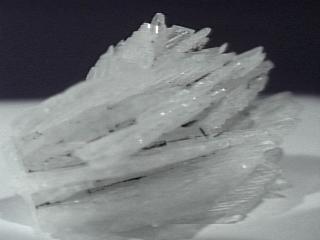
ALBITE specimen alb-2
$ 30.00
$ 30.00
Dims: 2.6" x 1.7" x 1.5"(6.6 x 4.3 x 3.8 cm)
Wt: 2.97 oz.(84.2 g)
Sao Jose do Safira, Minas Gerais, Brazil
An example of the variety of Albite that is called Cleavelandite, this specimen has the thin, pseudohexagonal bladed crystals that one would expect. Though their intergrowth and close proximity to each other make it difficult to define individual crystals, some of the blades achieve over 1"(2.5 cm) in height and over 2"(5.1 cm) in length. These blades have a pearly luster and a white-to-colorless color, and are quite well-formed. They are transparent, though heavy internal fracturing in a hexagonal pattern interrupts a clear view through the crystals. There is no host rock on the specimen; it is basically a cluster of Cleavelandite blades. Ah, yes, it also has some tiny, blue-to-brown tourmaline crystals growing in some of the crevices between the blades.

alb-2 ($ 30.00)
Sao Jose do Safira, Minas Gerais, Brazil

ALBITE specimen alb-3
$ 30.00
$ 30.00
Dims: 2.4" x 1.4" x 1.4"(6.1 x 3.6 x 3.6 cm)
Wt: 2.71 oz.(76.9 g)
Sao Jose do Safira, Minas Gerais, Brazil
This Albite specimen not only has good crystal form, it also has a few additive that make it a bit more interesting. The Albite is in the form of many crystals that are aggregated into a compact mass. They have a columnar appearance along their prism faces, a flat, basal termination, and a hexagonal cross-section. Their color is a uniform milky-white and they are translucent, both of which may be caused by the intense and profuse internal fracturing in each crystal. Their luster is pearly. There are 2 small but very well-formed books of muscovite at one end of the specimen and several minute, rounded crystals of herderite, a calcium beryllium phosphate chloride, along one side. Besides these minerals, there is no other material.

alb-3 ($ 30.00)
Sao Jose do Safira, Minas Gerais, Brazil

ALBITE specimen alb-4
$ 25.00
$ 25.00
Dims: 2.4" x 1.5" x 1.8"(6.1 x 3.8 x 4.6 cm)
Wt: 2.44 oz.(69.3 g)
Sao Jose do Safira, Minas Gerais, Brazil
There are two varieties of Albite on this specimen: what we know as Albite, and the flat, tabular variety known as Cleavelandite. The Albite occurs as a portion of a crystal with only one definable face and what appears to be heavy water-wear, but is more likely the natural form of the material, creating crevices and hollows throughout its area. Out of the crystal face of the Albite erupts two rounded aggregates of Cleavelandite crystals, with excellent pseudohexagonal crystal form, white color and pearly luster. The blades achieve a maximum size of about 1.4"(3.6 cm) and are lightly sprinkled with tiny pyrite crystals, as is the Albite's surface. Opposite the Cleavelandite, there are a few shattered crystals of green tourmaline on the Albite, which acts as the host rock on this piece.

alb-4 ($ 25.00)
Sao Jose do Safira, Minas Gerais, Brazil

ALBITE specimen alb-5
$ 30.00
$ 30.00
Dims: 3.2" x 2.4" x 1.8"(8.1 x 6.1 x 4.6 cm)
Wt: 7.38 oz.(209.2 g)
Sao Jose do Safira, Minas Gerais, Brazil
This is the ideal specimen for one who likes hexagonal form and tendencies. First there are at least 20 Albite crystals of the variety Cleavelandite, with pseudohexagonal flat, platy crystals that are colored a blue-white. They have a pearly to vitreous luster and show a dim transparence along their edges that is interrupted by heavy internal fracturing, aligned in a hexagonal form. These blades are incomplete but large, measuring over 2.5 x 1"(6.4 x 2.5 cm). Attached to the Cleavelandite is a hexagonal book of muscovite/lepidolite mica. Its form is rough, but can be determined because of the demarcation line where the muscovite ends its growth and the lepidolite commences. It is a rather odd formation that I have not seen before. Finally, there are a few random shards of green tourmaline that span some of the crevices between the Cleavelandite blades. One tiny broken piece shows its hexagonal cross-section in the middle of one of the Cleavelandites' faces. I think that the lepidolite/muscovite really helps to make the piece as interesting as it is.
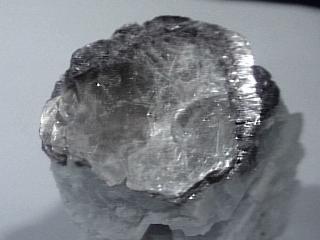

alb-5 ($ 30.00)
Sao Jose do Safira, Minas Gerais, Brazil

$ 150.00
Dims: 4.3" x 3.3" x 3.0"(10.9 x 8.4 x 7.6 cm)
Wt: 1 lb., 6.5 oz.(639 g)
Aracuai, Minas Gerais, Brazil
I had difficulty in figuring this specimen out. It is made up of a cluster of several intergrown Albite crystals, including what appear to be 2 sets of twins, and some attached Cleavelandite. Actually, one of the twins seems to be made up of 3 crystals, two of which are twinned to the first one, but in different directions off of different planes! This is really a strange piece, and I am having difficulty figuring out which faces go with which crystal. The Albite has the standard creamy color and pearly luster, and is translucent around its edges. The attached cleavelandite is whiter, with an almost green tinge to it. There are several spots of noticeable damage on it, and a small amount of material is missing, but it is nonetheless in good condition. Besides these minerals, there is no other material. This is one of the best-formed, most complete specimens of Albite that I have seen for its size.


Aracuai, Minas Gerais, Brazil

ALBITE specimen alb-7
$ 28.00
$ 28.00
Dims: 5.3" x 3.9" x 3.6" (13.5 x 9.9 x 9.1 cm)
Wt: 2 lbs., 10.4 oz. (1.202 kg)
Stewart Mine, California, U.S.A.
With this specimen, one is getting a lot of Albite for a relatively small price! It consists of a large, malformed but nearly complete crystal that is intergrown with a portion of another large but broken crystal. It has the standard beige coloration and pearly luster of Albite, and is, of course, opaque. It is partially covered by a thin crust that, oddly enough, appears to be made up of hundreds of tiny, intergrown stilbite crystals! This crust also covers many small, well-formed but damaged books of lepidolite mica. It is an intricate specimen; not only does it have all of that stilbite, but the growth patterns on the Albite's surface are complex, and some of them form crevices that descend rather deeply into the crystal, and are lined with more stilbites.


alb-7 ($ 28.00)
Stewart Mine, California, U.S.A.

ALBITE specimen alb-8
$ 45.00
$ 45.00
Dims: 5.1" x 4.0" x 1.8"(13.0 x 10.2 x 4.6 cm)
Wt: 1 lb., 2.9 oz.(537 g)
Minas Gerais, Brazil
While Albite is a rather common and mundane mineral from many points of view, this specimen has a few very attractive aspects to it. The Albite occurs in the triclinic form, and makes up a large mass through the intergrowth of three smaller masses; these smaller masses are composed of many small intergrown prismatic crystals that are generally aligned in a single direction. They have a pale beige color and a pearly to waxy luster. None of their visible dimensions exceed 0.5" (1.3 cm), and more than 50% of each crystal's volume is obscured through their intense intergrowth. They form a crust that seems to rest on a mass of rather finely-grained Albite that is intermixed with equally fine smoky quartz crystals or fragments. Resting on top of the Albite crust is a smoky quartz crystal that is in excellent condition and appears to have no damage. It is in the hexagonal prismatic form, and its prism faces are sloped so that it almost appears to have the "Tessin Habit", but there are very small termination faces near its tip. It has a pale brown color and is transparent and mostly quite clear, though it clouds up a bit right near its base. Along with this quartz crystal is a thin, radiating cluster of many thin, long epidote crystals. They appear to be in good condition and range in size from 0.4- 1.0" (1.0- 2.5 cm). Their color is a moderately deep forest green with a bit of a yellowish hint, and they show definite transparence. The epidote and smoky quartz are situated a few inches away from and at right angles to each other, so they do not really make the specimen seem unbalanced. Altogether, it is a very attractive piece.

alb-8 ($ 45.00)
Minas Gerais, Brazil

ALBITE specimen alb-9
$ 70.00
$ 70.00
Dims: 5.5" x 2.2" x 1.5" (14.0 x 5.6 x 3.8 cm)
Wt: 11.4 oz. (327 g)
Golconda Mine, Governador Valadres, Minas Gerais, Brazil
This hand specimen consists of a "book", or stack of flat, platy Albite crystals. Their form identifies them as a variety known as Cleavelandite, that forms flat, almost tabular crystals with an often hexagonal outline. The crystals in this specimen are generally in very good condition, showing only a small amount of damage. As they are heavily intergrown, it is difficult to discern individual crystals; however, they still have relatively good form, with well-defined edges and clean faces that have a pearly-to-vitreous luster. They are colorless and transparent, but show so many internal fractures that clarity is almost nonexistent, and they appear to have a milky-white coloration. Accompanying the Albite are a few tiny patches of muscovite and several elbaite crystals. Most of these elbaites span small crevices between the Albite crystals, though a few rest parallel to them. They do not exceed 0.6" (1.5 cm) in length, and have good trigonal prismatic form. They are generally transparent, clear, and have a vitreous luster. Most of the elbaites show a moderately dark green color with a hint of blue, but a few of the larger, thicker ones appear to be black and opaque. I think that they add to the attractiveness of the specimen.
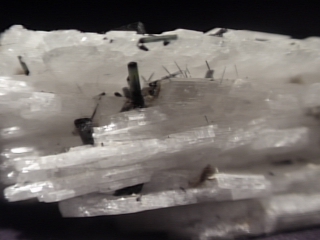

alb-9 ($ 70.00)
Golconda Mine, Governador Valadres, Minas Gerais, Brazil

ALBITE specimen alb-10
$ 60.00
$ 60.00
Dims: 1.9" x 1.8" x 1.0" (4.8 x 4.6 x 2.5 cm)
Wt: 2.19 oz. (62.1 g)
Capelinha, Minas Gerais, Brazil
This small hand specimen consists of scores of triclinic prismatic Albite crystals that show good form and relatively little damage. Only 7 or 8 of these crystals, however, exceed 0.2" (5 mm) in any dimension. The largest of these is by far the most noticeable, with visible dimensions of 1.9 x 1.0 x 0.9" (4.8 x 2.5 x 2.3 cm). Its form appears to be slightly warped, but the crystal still has well-defined, straight edges and flat faces that show either a waxy-to-pearly luster or a dull, matte luster. All are a milky-white in color and are dimly translucent. Most of the very small Albites are trapped in a small amount of an olive-green matrix that is attached to the large crystal. This matrix seems to be composed mostly of sphene, as there is a large crystal of it that is partially intergrown. It has visible dimensions of 0.6 x 0.2 x 0.2" (1.5 x 0.5 x 0.5 cm) and is damaged and incomplete, as one of its pointed ends was broken off. It has an olive-green color and an adamantine luster, and is partially transparent, though its heavy internal fracturing prevent it from being gem-quality.


alb-10 ($ 60.00)
Capelinha, Minas Gerais, Brazil

ALBITE specimen alb-11
$ 64.00
$ 64.00
Dims: 1.9" x 1.8" x 1.0" (4.8 x 4.6 x 2.5 cm)
Wt: 2.19 oz. (62.1 g)
Capelinha, Minas Gerais, Brazil
Approximately 20 separate and distinct Albite crystals rest on the edge of the Sphene-laden host rock of this specimen. These crystals are in excellent condition, showing no damage, and range in size from less than 2 millimeters along any axis to 0.6 x 0.5 x 0.3" (1.5 x 1.3 x 0.8 cm). Even with their sometimes intense intergrowth, they all show excellent triclinic prismatic form that features well-defined edges and clean faces which show a pearly luster. All have a creamy-white coloration and are moderately-to-dimly translucent. The host rock on which they rest has an olive-green color that is caused by the fact that it is completely suffused with crystals of sphene. The size of the crystals ranges from the near-microscopic to one particular crystal with dimensions of 0.4 x 0.2 x 0.1" (1.0 x 0.5 x 0.3 cm). The smallest crystals have a deep, almost forest-green coloration which pales as their size increases. Most of the easily visible sphenes have very good monoclinic bladed form, and the largest shows definite twinning. The larger crystals show a high, adamantine luster that dims as their size decreases, and those that are trapped within the host appear to be positively dull.
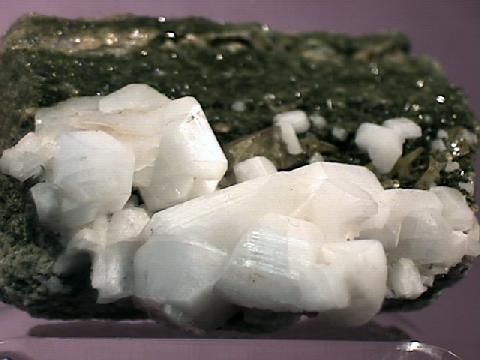

alb-11 ($ 64.00)
Capelinha, Minas Gerais, Brazil

ALBITE specimen alb-12
$ 48.00
$ 48.00
Dims: 4.2" x 4.0" x 2.0" (10.7 x 10.2 x 5.1 cm)
Wt: 1 lb., 0.6 oz. (471 g)
Sao Jose do Safira, Minas Gerais, Brazil
This hand specimen consists of part of a crust that is made up of the Cleavlandite variety of Albite. The Cleavlandite occurs as thin, bladed crystals that show a hexagonal outline. Though many of them show visible damage, most are in good condition and have well-defined edges and clean faces that show a pearly luster. They have a uniform white coloration that shows a very faint hint of blue and are translucent, though some of them show tiny patches of transparence along their edges. Among the Cleavlandite blades rest dozens of trigonal prismatic elbaite crystals. Many of these are damaged, and most appeasr to be missing their termanations. Their brownish-green color is so deep that only the thinnest crystals show any appreciable transparence, while the largest, thickest crystals are positively opaque. The smaller crystals show a bright, vitreous luster that dulls as their size increases, so that the largest crystals show a dull, almost waxy luster. There is no other material or host rock on the specimen.


alb-12 ($ 48.00)
Sao Jose do Safira, Minas Gerais, Brazil
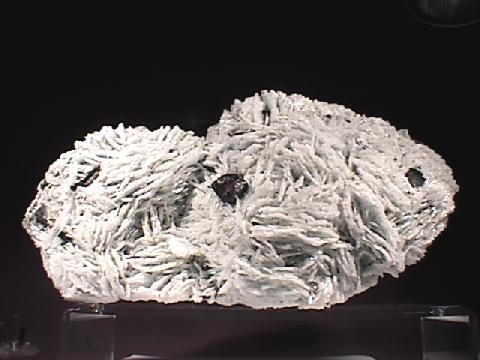
$ 210.00
Dims: 11.4 x 5.5 x 4.0" (29.0 x 14.0 x 10.2 cm)
Wt: 7.3 lbs. (3.3 kg)
Sao Jose do Safira, Minas Gerais, Brazil
This cabinet specimen consists almost entirely of a variety of Albite called Cleavlandite that forms pseudohexagonal tabular blades. These blades are intensely intergrown, so it is very difficult to determine their average individual dimensions. Though there are several areas that show obvious damage, this damage is generally minor. The form of the blades is excellent- their edges are sharp and their faces are clean, and possess a bright, vitreous luster. All have a milky white coloration with a faint hint of blue and are individually translucent, though the crust itself is essentially opaque. Scores of elbaite tourmaline crystals are scattered on the Cleavlandite; most of these are less than 0.1" (3 mm) thick, but a few are much larger and more substantial than that. One in particular is thick enough to show an obvious difference in color between the material on its surface and that in its core (see the close-up image). I have only just examined the underside of this specimen, and have seen three large geometric depressions that show that this crust grew atop a few large crystals of some mineral. There are a few large elbaites there, too- one of these measures nearly 3" (7.5 cm) long and 0.2-0.4" (5-10 mm) thick.


Sao Jose do Safira, Minas Gerais, Brazil

$ 190.00
Dims: 3.5 x 3.5 x 2.2" (8.9 x 8.9 x 5.6 cm)
Wt: 8.15 oz. (231.2 g)
Pederneira, Sao Jose do Safira, Minas Gerais, Brazil
This rather odd specimen consists of several pseudohexagonal Albite blades that are held together by a muscovite matrix. The Albites are of the variety known as Cleavelandite, and are generally in good condition, as there are a few areas of visible damage. The largest of these blades has dimensions of 1.6 x 1.6" (4.1 x 4.1 cm), and like all of the others, shows a slightly warped form that still has well-defined edges and clean faces. All are colorless, transparent and moderately to dimly clear, and possess the standard pearly luster. The muscovite matrix is the strange aspect of this piece, as it consists of several rather heavily warped "books" of pseudohexagonal sheets that have partly intersected. Where they have been cleaved, one can see that the muscovite actually makes up a "core" in each book, which is surrounded by an outer layer of dark, brownish-pink lepidolite that grew off of the muscovite. The point on each book where the muscovite ends and the lepidolite begins is remarkably defined. There are also a few dark green elbaite crystals present, along with a very small amount of pyrite or another metallic sulfide.


Pederneira, Sao Jose do Safira, Minas Gerais, Brazil

ALBITE specimen alb-15
$ 45.00
$ 45.00
Dims: 4.6 x 3.2 x 2.2" (11.7 x 8.1 x 5.6 cm)
Wt: 13.8 oz. (391.0 g)
Minas Gerais, Brazil
This hand specimen consists of a formation of intergrown Albites. The Albites are of the variety known as Cleavelandite, and show the obligatory pseudohexagonal bladed form. The formation is in very good condition, showing little human-induced damage, and the blades are very well-formed. They have the standard white coloration with a noticeable blue tinge and a pearly-to-vitreous luster, and are dimly transparent as individuals, though the formation as a whole is only dimly translucent. There is no host rock present, but a few tiny elbaite needles are visible among the blades.

alb-15 ($ 45.00)
Minas Gerais, Brazil

ALBITE specimen alb-16
$ 34.00
$ 34.00
Dims: 1.1 x 1.0 x 0.6" (2.8 x 2.5 x 1.5 cm)
Wt: 13.2 g w/ base
Capelinha, Minas Gerais, Brazil
Several small Albite crystals are intergrown to form 2 clusters on this thumbnail specimen. These crystals reach maximum dimensions of 0.6 x 0.5 x 0.5" (1.5 x 1.3 x 1.3 cm) and are in excellent condition, showing no visible damage. Though the largest crystal appears to be warped due to intergrowth, all have exceptional monoclinic prismatic form with well-defined edges and clean faces. They have an unusually bright, white coloration, are translucent, and have a luster that ranges from pearly to nearly matte from face to face. The Albites are accompanied by many small sphenes that are heavily intergrown but have good monoclinic form. All are transparent but heavily internally fractured and have the classic olive-green coloration and adamantine luster. The base on which these crystals rest is made up of either tiny crystals or granules of both Albite and sphene, and the piece is hot-glued onto a flat, square acrylic base.

alb-16 ($ 34.00)
Capelinha, Minas Gerais, Brazil

ALBITE specimen alb-17
$ 200.00
$ 200.00
Dims: 3.1 x 1.7 x 1.2" (7.9 x 4.3 x 3.0 cm)
Wt: 2.55 oz. (72.4 g)
Capelinha, Minas Gerais, Brazil
At least 30 discernable Albite crystals rest on the sparse green base of this specimen. These Albites are generally in very good condition- most of the visible damage occurred prior to mining. The largest of these crystals has dimensions of 0.9 x 0.5 x 0.5" (2.3 x 1.3 x 1.3 cm). Though several are badly warped due to changes in growing conditions, most have exceptional triclinic prismatic form, with very well-defined edges and clean faces. Their color is nearly pure white and their luster ranges from waxy to pearly, and all are translucent. They are accompanied by a few visible sphene crystals that have excellent form, an olive-green color and the standard adamantine luster. The base on which these crystals rest appears to me made up of either fine, intergrown crystals or granular bits of more sphene, though there is likely a quantity of chlorite present.


alb-17 ($200.00)
Capelinha, Minas Gerais, Brazil

ALBITE specimen alb-18
$ 25.00
$ 25.00
Dims: 4.95x3.47x2.34" (12.56x8.81x5.95cm)
Wt: 24.73oz (701g)
Aracuai, Minas Gerais, Brazil
This specimen of albite shows the pattern of loosely stacked thin plates called "clevelandite". The specimen appears white and opaque, with a vitreous luster apparent on flat surfaces. However, a loupe reveals that the crystals are actually transparent and nearly colorless, with an interesting growth pattern on the surface that when added to the myriad internal fractures gives the specimen a nearly white appearance.


alb-18 ($ 25.00)
Aracuai, Minas Gerais, Brazil